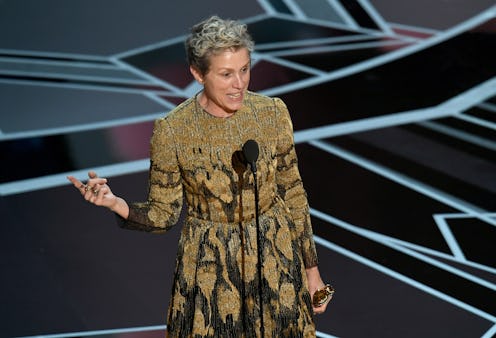Entertainment
How Jessica Chastain, Dee Rees & More Already Use "Inclusion Riders" To Get More Women Hired

"I have two words to leave you with tonight, ladies and gentlemen: inclusion rider." These were the last words of Frances McDormand's Best Actress speech at the 2018 Oscars, immediately prompting everyone watching at home to look up what an inclusion rider is. Backstage in the press room, McDormand defined an inclusion rider, via Variety, as a clause in a contract "that means that you can ask for and/or demand at least 50 percent diversity, in not only the casting but the crew." Yet while it's only now getting a moment in the spotlight thanks to the actor's speech, inclusion riders have actually been around for years, used to shift expectations about equality both in front of and behind the camera.
McDormand, though, who was first nominated for an Oscar in 1989, admitted that she had just learned of the term "inclusion rider" one week prior to the awards. "And so, the fact that I just learned that after 35 years of being in the film business... we're not going back," she said. The actor said she saw the inclusion rider as a concrete step in the filmmaking business to ensure that demands for equality and diversity in Hollywood are more than just fads, but result in actual, contractual change. "The whole idea of women trending? No, no trending. African Americans trending? No, no trending. It changes now, and I think the inclusion rider will will have something to do with that," she said.
The inclusion rider began as a strategy envisioned by Stacy L. Smith, the director of USC Annenberg 's Media, Diversity, & Social Change Initiative, and civil rights attorney Kalpana Kotagal, according to Vanity Fair. Smith first floated the idea in 2014, suggesting in an article for The Hollywood Reporter that stars committed to increasing the number of female speaking roles on screen "put equity in the contract." Wrote Smith, "If notable actors working across 25 top films in 2013 had made this change to their contracts, the proportion of balanced films (about half-female) would have jumped from 16 percent to 41 percent."
Her initial idea, not yet called the inclusion rider, was that actors could stipulate that a star could demand that the demographics of all speaking roles or featured extras reflect the demographics of real life. Smith expanded on the idea in her 2016 TED talk, saying, "An equity rider by an A-lister in their contract can stipulate that those roles reflect the world in which we actually live."
Though the concept of the inclusion rider has been around for some time, Smith and Kotagal have recently campaigned more adamantly for the contractual clause with the emergence of #MeToo and the Time's Up movement, bringing the concept directly to agencies. "We're hoping agencies can ask every actor, 'Would you like an inclusion rider?'" Smith told Vanity Fair. "If you get the Hollywood elite to adopt it in their contracts, it becomes baked in."
Of course, inclusion riders will only work if big name celebrities, like the many A-listers sitting in the Oscars crowd for McDormand's speech, use it. And it seems that many, like McDormand, had never even heard of the possibility until recently. "It's something we didn't know we could demand," Meryl Streep told Vanity Fair after the Oscars. "It's because girls ask for permission, but now, we are just bursting. It was a great night." Going forward, hopefully both women and men will take advantage of inclusion riders. Jessica Chastian successfully used an inclusion rider-like strategy recently when she negotiated salaries for both her and Octavia Spencer, insisting that they make the same salary on an upcoming production. And Brie Larson, who won the award for Best Actress in 2016, pledged to begin demanding an inclusion rider on Twitter following McDormand's speech, tweeting, "I'm committed to the Inclusion Rider. Who's with me?"
Inclusion riders essentially provide quotas for hiring practices, which is something that directors and studio heads could also enact for themselves, without the need of stars to step in. And a few people have taken this step, though perhaps without exact numerical accuracy. Dee Rees, who was Oscar-nominated for Best Adapted Screenplay for her film Mudbound, told Vanity Fair that she has been adamant about hiring women and people of color to be part of her crew since her debut film, Pariah. "It's great to make it contractual because that is what will change the business," she told Vanity Fair.
Following the #OscarsSoWhite controversy of 2016, J.J. Abrams, director of Star Wars: The Force Awakens, also committed to ensuring that applications for all jobs submitted to his production company Bad Robot would reflect the demographics of the U.S. population in 2016. "We're working to find a rich pool of representative, kick-ass talent and give them the opportunity they deserve and we can all benefit from," he said, via The Hollywood Reporter. "It's good for audiences and it's good for the bottom line."
Ryan Murphy (Glee, American Crime Story) made a similar pledge that year, declaring that his production company would aim to have 50 percent of its directors be "women, people of color, and members of the LGBT community," as reported by The Hollywood Reporter. "The industry has always been about, you come to us," he said. "there's not a lot of effort and inclusion, and I'm saying, 'No, we're going to go to you.'"
There's no doubt that McDormand's call to action will inspire actors to begin demanding change on their sets, but Smith made clear that it is ideally something agencies will adopt as company policy. "I hope I get calls from the agencies tomorrow saying they want to adopt this across all talent," Smith told The Guardian immediately following the awards ceremony. "I'm hoping to make a lot of attorneys really busy." Fingers crossed that's exactly what happens.